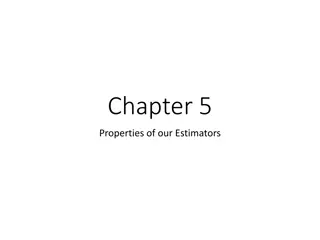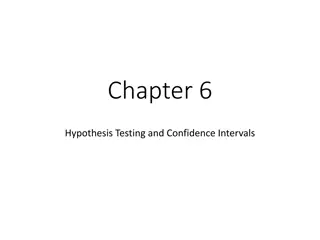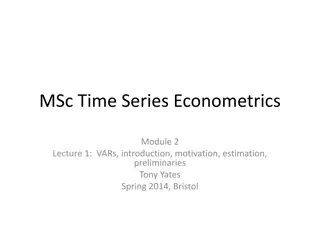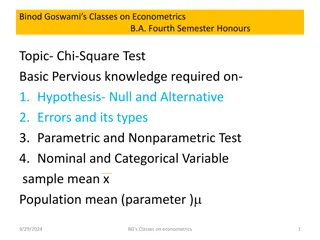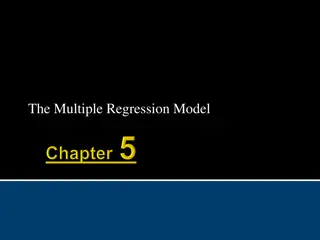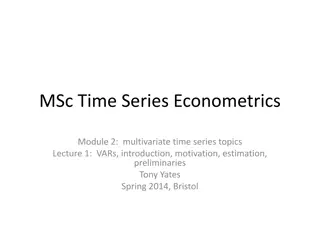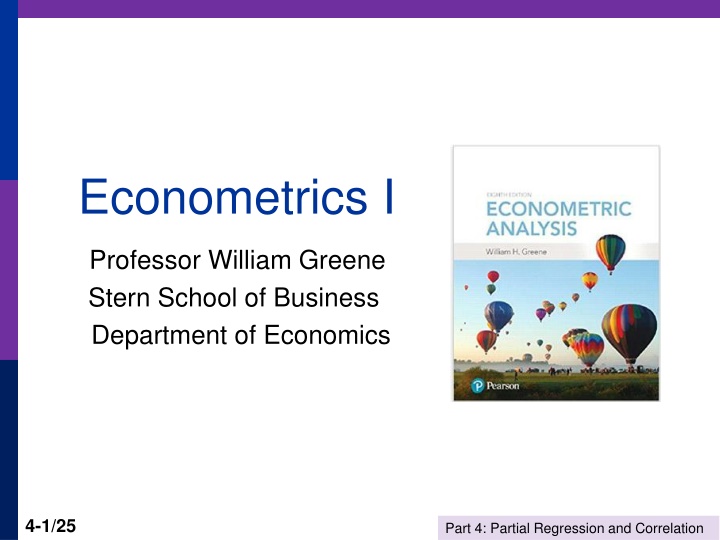
Econometrics I: Partial Regression and Correlation Methods
Explore Frisch-Waugh theorem, partitioned solution, inverse techniques, and their implications in econometrics for regression analysis and correlation. Understand the algebraic expressions and practical applications related to partial regression coefficients.
Download Presentation

Please find below an Image/Link to download the presentation.
The content on the website is provided AS IS for your information and personal use only. It may not be sold, licensed, or shared on other websites without obtaining consent from the author. If you encounter any issues during the download, it is possible that the publisher has removed the file from their server.
You are allowed to download the files provided on this website for personal or commercial use, subject to the condition that they are used lawfully. All files are the property of their respective owners.
The content on the website is provided AS IS for your information and personal use only. It may not be sold, licensed, or shared on other websites without obtaining consent from the author.
E N D
Presentation Transcript
Econometrics I Professor William Greene Stern School of Business Department of Economics 4-1/25 Part 4: Partial Regression and Correlation
Econometrics I Part 4 Partial Regression and Partial Correlation 4-2/25 Part 4: Partial Regression and Correlation
Frisch-Waugh (1933) Theorem Context: Model contains two sets of variables: X = [ (1,time) : (other variables)] = [X1X2] Regression model: y = X1 1 + X2 2 + (population) = X1b1 + X2b2 + e (sample) Problem: Algebraic expression for the second set of least squares coefficients, b2 4-3/25 Part 4: Partial Regression and Correlation
Partitioned Solution Method of solution (Why did F&W care? In 1933, matrix computation was not trivial!) Direct manipulation of normal equations produces + = + = 2 1 1 2 2 2 2 X X b X X b X y ==> X X b = 2 ( ) = X X b X y 2 2 X X X X X X X X X y X y 1 1 1 2 1 X =[X X X X = X y= , ] so and 1 2 2 1 2 2 X X X X X X b X X X X b b X y X y 1 1 1 2 1 1 (X X)b = = 2 1 2 X y 2 2 X X b 1 1 1 1 2 2 1 2 2 2 = X y- X X b X (y- X b ) 2 2 1 1 1 1 4-4/25 Part 4: Partial Regression and Correlation
Partitioned Solution Direct manipulation of normal equations produces b2 = (X2 X2)-1X2 (y - X1b1) What is this? Regression of (y - X1b1) on X2 If we knew b1, this is the solution for b2. Important result (perhaps not fundamental). Note the result if X2 X1 = 0. Useful in theory: Probably Likely in practice? Not at all. 4-5/25 Part 4: Partial Regression and Correlation
Partitioned Inverse Use of the partitioned inverse result produces a fundamental result: What is the southeast element in the inverse of the moment matrix? -1 X 'X X 'X X 'X X 'X 1 1 1 2 2 1 2 2 4-6/25 Part 4: Partial Regression and Correlation
Partitioned Inverse The algebraic result is: [ ]-1(2,2) = {[X2 X2] - X2 X1(X1 X1)-1X1 X2}-1 = [X2 (I - X1(X1 X1)-1X1 )X2]-1 = [X2 M1X2]-1 Note the appearance of an M matrix. How do we interpret this result? Note the implication for the case in which X1 is a single variable. (Theorem, p. 37) Note the implication for the case in which X1 is the constant term. (p. 38) 4-7/25 Part 4: Partial Regression and Correlation
Frisch-Waugh (1933) Basic Result Lovell (JASA, 1963) did the matrix algebra. Continuing the algebraic manipulation: b2 = [X2 M1X2]-1[X2 M1y]. This is Frisch and Waugh s famous result - the double residual regression. How do we interpret this? A regression of residuals on residuals. We get the same result whether we (1) detrend the other variables by using the residuals from a regression of them on a constant and a time trend and use the detrended data in the regression or (2) just include a constant and a time trend in the regression and not detrend the data Detrend the data means compute the residuals from the regressions of the variables on a constant and a time trend. 4-8/25 Part 4: Partial Regression and Correlation
Important Implications Isolating a single coefficient in a regression. (Corollary 3.2.1, p. 37). The double residual regression. Regression of residuals on residuals partialling out the effect of the other variables. It is not necessary to partial the other Xs out of y because M1 is idempotent. (This is a very useful result.) (i.e., X2 M1 M1y = X2 M1y) (Orthogonal regression) Suppose X1 and X2 are orthogonal; X1 X2 = 0. What is M1X2? 4-9/25 Part 4: Partial Regression and Correlation
Applying Frisch-Waugh Using gasoline data from Notes 3. X = [1, year, PG, Y], y = G as before. Full least squares regression of y on X. Partitioned regression strategy: 1. Regress PG and Y on (1,Year) (detrend them) and compute residuals PG* and Y* 2. Regress G on (1,Year) and compute residuals G*. (This step is not actually necessary.) 3. Regress G* on PG* and Y*. (Should produce -11.9827 and 0.0478181. 4-10/25 Part 4: Partial Regression and Correlation
Detrending the Variables Pg Pg* are the residuals from this regression 4-11/25 Part 4: Partial Regression and Correlation
Regression of detrended G on detrended Pg and detrended Y 4-12/25 Part 4: Partial Regression and Correlation
Partial Regression Important terms in this context: Partialing out the effect of X1. Netting outthe effect Partial regression coefficients. To continue belaboring the point: Note the interpretation of partial regression as net of the effect of This is the (very powerful) Frisch Waugh Theorem. This is what is meant by controlling for the effect of X1. Now, follow this through for the case in which X1 is just a constant term, column of ones. What are the residuals in a regression on a constant. What is M1? Note that this produces the result that we can do linear regression on data in mean deviation form. 'Partial regression coefficients' are the same as 'multiple regression coefficients.' It follows from the Frisch-Waugh theorem. 4-13/25 Part 4: Partial Regression and Correlation
Partial Correlation Working definition. Correlation between sets of residuals. Some results on computation: Based on the M matrices. Some important considerations: Partial correlations and coefficients can have signs and magnitudes that differ greatly from gross correlations and simple regression coefficients. Compare the simple (gross) correlation of G and PG with the partial correlation, net of the time effect. (Could you have predicted the negative partial correlation?) 4.50 4.00 CALC;list;Cor(g,pg)$ Result = .7696572 3.50 3.00 PG 2.50 2.00 CALC;list;cor(gstar,pgstar)$ Result = -.6589938 1.50 1.00 .50 70 80 90 100 110 120 G 4-14/25 Part 4: Partial Regression and Correlation
Partial Correlation 4-15/25 Part 4: Partial Regression and Correlation
THE Most Famous Application of Frisch-Waugh: The Fixed Effects Model A regression model with a dummy variable for each individual in the sample, each observed Ti times. There is a constant term for each individual. yi = Xi + di i + i, for each individual N columns y y X X d 0 0 d 0 0 0 0 1 1 1 N may be thousands. I.e., the regression has thousands of variables (coefficients). 2 2 2 = + y X 0 0 0 d N N N + [X,D] = + Z = 4-16/25 Part 4: Partial Regression and Correlation
Application Health and Income German Health Care Usage Data, 7,293 Individuals, Varying Numbers of Periods Variables in the file are Data downloaded from Journal of Applied Econometrics Archive. This is an unbalanced panel with N = 7,293 individuals. There are altogether n = 27,326 observations. The number of observations ranges from 1 to 7 per family. (Frequencies are: 1=1525, 2=2158, 3=825, 4=926, 5=1051, 6=1000, 7=987). The dependent variable of interest is DOCVIS = number of visits to the doctor in the observation period HHNINC = household nominal monthly net income in German marks / 10000. (4 observations with income=0 were dropped) HHKIDS = children under age 16 in the household = 1; otherwise = 0 EDUC = years of schooling AGE = age in years We desire also to include a separate family effect (7293 of them) for each family. This requires 7293 dummy variables in addition to the four regressors. 4-17/25 Part 4: Partial Regression and Correlation
Estimating the Fixed Effects Model The FE model is a linear regression model with many independent variables 1 b X X D X X D D D X y D y a = Using the Frisch-Waugh theorem =[ ] D 1 b X M X X M y D 4-18/25 Part 4: Partial Regression and Correlation
Fixed Effects Estimator (cont.) 1 = d 0 M I D D D 0 d ( ) D D 0 0 1 2 = D ... 0 0 d N 1 d d 0 0 0 1 0 2 d d = 2 DD ... N 0 0 d d N 4-19/25 Part 4: Partial Regression and Correlation
Fixed Effects Estimator (cont.) 1 = M I D D D ( ) D D 1 D M 0 0 0 0 2 D M = M (The dummy variables are orthogonal) D I N D 0 0 M i i D 1 = M d dd ( ) d =I (1/T) dd T i i T i i i i 1- - ... - 1 T 1 T 1 T i i i - 1- ... - 1 T 1 T 1 T = i i i ... - ... - ... ... 1- ... 1 T 1 T 1 T i i i 4-20/25 Part 4: Partial Regression and Correlation
Within Transformations ( X ) ) ( ) i i D 1 = M X I d dd ( ) d X = I (1/T) dd X i T i i i T i i i i i ( i i i = = = (T X M X = XM X (1/T) d d X X (1/T) (T (T d x ) X dx i i i i i i i i i i K) 1)*(1 K) i i i N i=1 XM X i D , D i T t=1 i i D = (x -x )(x -x ) (k,l element) i i it,k i.,k it,l i.,l k,l i N i=1 XM y i D X M y = XM y , D i T t=1 i i D = (x -x )(y -y ) i i it,k i.,k it i. k 4-21/25 Part 4: Partial Regression and Correlation
Least Squares Dummy Variable Estimator bis obtained by within groups least squares (group mean deviations) Normal equations for a are D Xb+D Da=D y a = (D D)-1D (y Xb) (see slide 5) iT i i t=1 a=(1/T) x b (y - )=e it it i 4-22/25 Part 4: Partial Regression and Correlation
A Fixed Effects Regression Constant terms 4-23/25 Part 4: Partial Regression and Correlation
What happens to a time invariant variable such as gender? f = a variable that is the same in every period (FEMALE) iT t=1 n i=1 i i D n i=1 2 = = f M f fM f (f -f ) D i it i. = = but f = f, so f This is a simple case of multicollinearity. = f i diag(f)*D f and (f -f ) 0 for all i and t it i it i. it i. 4-24/25 Part 4: Partial Regression and Correlation
4-25/25 Part 4: Partial Regression and Correlation





